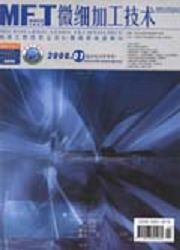

 中文摘要:
中文摘要:
对多量子阱红外探测器制作中GaAs衬底减薄工艺程序进行了研究与讨论。通过将器件压焊封装进杜瓦瓶中,测量其室温和低温条件下I-V特性,以及在低温条件下的器件信噪比,并以傅里叶变换红外光谱仪对器件进行光谱测量,得到光电流谱,从而比较了将器件衬底磨45°斜角的边耦合情况,以及直接将衬底减薄至(29±2)μm两种情况下器件的性能。并讨论了减薄材料在垂直入射情况下仍能引起器件光吸收的主要原因。结果表明,由于GaAs材料的各向异性,湿法腐蚀会使器件台面形成正梯形和倒梯形结构,其作用等同于器件磨至45°斜角,因此在垂直入射时器件也会有光电流产生。此外,在衬底进行减薄抛光后,衬底会有很小的起伏,这也可能引起光耦合,从而产生光电流。
 英文摘要:
英文摘要:
The processes of thinning GaAs substrate in fabrication of quantum wells photodetector (QWIP) was discussed. Performances of the device with (29 ± 2) μm thickness of GaAs substrate and the one with polishing a 45 ° facet on the substrate were compared to each other. The devices were mounted in a dewar for the I-V characteristics measurements at different temperatures. The relevant of signal voltage and noise voltage was also measured at 77 K. The absorption measurement of the devices was performed in a fourier transform infrared spectrometer(FTIR). By analyzing the experimental result, the reasons for perpendicular incidence inducing light absorption is discussed. The result shows that the mesas become trapezoid and inverse trapezoid structures due to anisotropism of GaAs material. This can induce current as perpendicular incidence inducing light absorption happens.
 同期刊论文项目
同期刊论文项目
 同项目期刊论文
同项目期刊论文
 期刊信息
期刊信息
